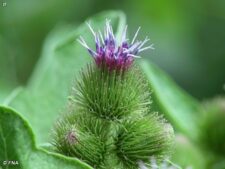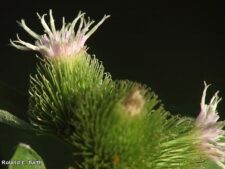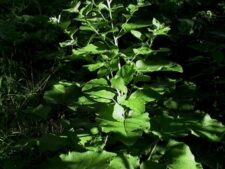
This naturalized biennial was introduced from Eurasia. A rosette of large leaves appears the first year (E). During the second year a stout plant up to 6 feet tall is produced, with lower leaves up to 22 inches long and nearly as wide (A,F). The young plants resemble rhubarb. The thistle-like flower heads appear purple (actually tri-colored as shown in the close-up, with corolla violet, anthers blue and stigmas white); rarely all white (B,C,D). Unlike thistles, which disperse their seeds by the wind, the dried burdock flower heads become spherical burs, with hooked bristles reminding us of Velcro. The burs cling to animal fur and clothing. Identified by its purple thistle-like flower head and spherical burs. The burs of the Cocklebur (Xanthium strumarium) are similar, but elongated.
Found in open woodlands, flowering from July through September. In Fontenelle Forest, common along Redbud Trail.
Common burdock was probably dispersed in North America by the overland traffic of livestock. The young leaves and roots are edible. Parts of these plants were used by Eurasian settlers for various medicinal purposes.
The content of NatureSearch is provided by dedicated volunteer Naturalists of Fontenelle Forest who strive to provide the most accurate information available. Contributors of the images retain their copyrights. The point of contact for this page is: Roland Barth.





